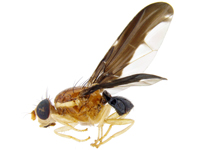Abstract
The genus Gazoryctra Hübner comprises 10 species in North America and four in northern Eurasia. The remaining diversity of North American Hepialidae is represented by four species of Sthenopis Packard, three species of Phymatopus Wallengren, and one species of Korscheltellus Börner (Nielsen et al. 2000; Grehan & Knyazev 2019). The North American distribution of Gazoryctra extends between Alaska and southern Appalachians and southern Rocky Mountains (Grehan & Mielke 2018). As with other North American Hepialidae, Gazoryctra is absent from much of the southern-central United States where there is ostensibly suitable habitat present as this genus is found in forested regions where it is believed to feed on roots or other organic matter (Schweitzer et al. 2011). This absence may be due to the lack of colonization following regression of inland seas that covered much of this region until the end of the Mesozoic (Grehan & Mielke 2018).
References
Beaver, E. & Moore, M. (2020) A new species of Fraus Walker 1856 (Lepidoptera: Hepialidae) from the south-west of Western Australia. Australian Entomologist, 47 (1), 39–50.
Edwards, H. (1885) Apparently new species of N. American Heterocera. Papilio, 4, 121–126.
Ferguson, D.C. (1979) A new ghost moth from the southern Appalachian Mountains Journal of the Lepidopterist’s Society, 33, 192–196.
Grehan, J.R. (1998) Survey of Semiothisa fraserata (Geometridae) and Gazoryctra sciophanes (Hepialidae) in the southern Appalachians. Unpublished report for the U.S. Fish and Wildlife Service, Ashville, North Carolina, 36 pp.
Grehan, J.R. (2010) Structural variants in the morphology of the first abdominal tergite supporting the monophyly of the Latin American genera Cibyra Walker, Druceiella Viette, Pfitzneriana Viette and Trichophassus Le Cerf (Lepidoptera: Hepialidae). Bulletin of the Buffalo Museum of Science, 39, 43–63.
Grehan, J.R. (2012) Morphological evidence for phylogenetic relationships within the Hepialidae (Lepidoptera: Exoporia). Bulletin of the Buffalo Museum of Science, 42, 33–62.
Grehan, J.R. & Knyazev, S. (2019) Potential influence of Mesozoic and Cenozoic tectonics on the evolution of European Hepialidae (Lepidoptera). Biogeographia, 34, 17–32.
https://doi.org/10.21426/B634143499
Grehan, J.R. & Mielke, C.G.C. (2017) Re-characterization of Gymelloxes with a redescription of Gymelloxes terea from Central America (Lepidoptera: Hepialidae). Zootaxa, 4363 (3), 434–440.
https://doi.org/10.11646/zootaxa.4363.3.8
Grehan, J.R. & Mielke, C.G.C. (2018) Evolutionary biogeography and tectonic history of the ghost moth families Hepialidae, Mnesarchaeidae, and Palaeosetidae in the Southwest Pacific (Lepidoptera: Exoporia). Zootaxa, 4415 (2), 243–275.
https://doi.org/10.11646/zootaxa.4415.2.2
Mielke, C.G.C. & Casagrande, M.M. (2013) A new Cibyra Walker, 1856 from Southern Brazil (Lepidoptera, Hepialidae). Nachrichten entomologische Vereins Apollo, Neue Folge, 34 (1/2), 73–86.
Moth Photographers Group (2020) Available from: https://www.mothphotographersgroup.msstate.edu (accessed 12 November 2020)
Nielsen, E.S. & Kristensen, N.P. (1989) Primitive ghost moths. Morphology and taxonomy of the Australian genus Fraus Walker (Lepidoptera: Hepialidae s. lat.). Monographs on Australian Lepidoptera, 1, 1–206.
https://doi.org/10.1071/9780643105096
Nielsen, E.S., Robinson, G.S. & Wagner, D.L. (2000) Ghost-moths of the world: a global inventory and bibliography of the Exoporia (Mnesarchaeoidea and Hepialoidea) (Lepidoptera). Journal of Natural History, 34, 823–878.
https://doi.org/10.1080/002229300299282
Nielsen, E.S. & Scoble, M.J. (1986) Afrotheora, a new genus of primitive Hepialidae from Africa (Lepidoptera: Hepialoidea). Entomologica Scandinavica, 17, 29–54.
https://doi.org/10.1163/187631286X00107
Rawlins, J.E., Thompson, S.A., Androw, R.A., Davidson, R.L. & Young, C.W. (1998) Temporal and spatial relationships of non-target insects in gypsy moth susceptible forests, Cheat Ranger District, Monongahela National Forest, West Virginia. Final Report to United States Forest Service, Monongahela National Forest, Elkins, West Virginia. United States Forest Service, Monongahela National Forest, Elkins, West Virginia, 421 pp.
Schweitzer, D.F., Minno, M.C. & Wagner, D.L. (2011) Rare, declining, and poorly known butterflies and moths (Lepidoptera) of forests and woodlands in the Eastern United States. U.S. Forest Service, Forest Health Technology Enterprise Team, FHTET-2011-01. USDA Forest Service, Morgantown, West Virginia, 517 pp.
Simonsen, T.J. (2018) Splendid ghost moths and their allies. A revision of Australian Abantiades, Oncopera, Aenetus and Zelotypia. Monographs of Australian Lepidoptera, 12, 1–312.
https://doi.org/10.1071/9781486307487
Tshistjakov, Y.A. (1997) Taxonomic study of the Far Eastern Hepialidae (Lepidoptera). Record 3. Review of the genus Gazoryctra Hübner, [1820], from the Asian part of Russia. Japan Heterocerist’s Journal, 194, 314–320.
Wagner, D.L. & Tindale, N.B. (1988) An appraisal of Gazoryctra Hübner (Hepialidae) and description of a new species from Arizona and New Mexico. Journal of the Lepidopterist’s Society, 42, 204–212.


